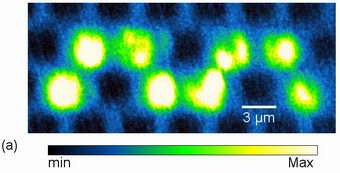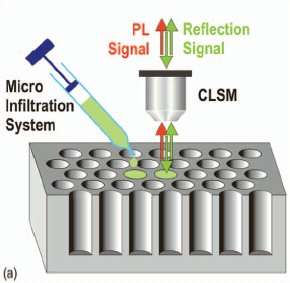December 4, 2006 feature
Water acts as a 'light switch' on photonic circuits

Using water to “write” light, scientists have designed a photonic circuit inside a photonic crystal that combines several optical elements. As the optical equivalent of an electronic circuit, this design marks another step on the path to realizing all-optical devices for communication and IT applications.
“All-optical devices use light instead of electrons to carry information,” co-author Francesca Intonti explained to PhysOrg.com. “Light has several advantages over electrons. It can travel in a dielectric material at much greater speeds than an electron in a metallic wire. Light can also carry a larger amount of information per second. The bandwidth of dielectric materials is significantly larger than that of metals. Furthermore, photons are not as strongly interacting as electrons, which helps reduce energy losses.”
In their study, Intonti et al. turned the pores of photonic crystals into individual photonic circuits by infiltration of a liquid of a specific refractive index. For the past several years, scientists have been exploiting photonic crystals because of the periodic arrangement of the refractive index that causes light to cancel at some frequencies. This structure results in a band gap, or a range of frequencies where light cannot propagate through the crystal.

By choosing a liquid with a large refractive index, Intonti et al. could introduce a permitted state within the band gap. In their experiment, the scientists used a solution of water and a colored organic dye called Rhodamine 6G (for fluorescence observation).
“In photonic crystals, you can introduce a permitted state in the band gap by intentionally introducing a defect in the otherwise perfect crystal,” said Intonti. “Therefore, in order to create a permitted state in the band gap, we physically introduced the Rhodamine solution in a single pore of the crystal: the infiltrated pore acts as a defect that determines the appearance of a permitted state in the band gap.”
The amount of liquid in a single photonic crystal pore is only about a thousandth of the volume of a droplet used in ink jet printers. In order to work on this scale, the scientists used a microinfiltration system—originally developed for transferring liquid in biological cells—to obtain a positioning precision of 0.1 micrometers. This microinfiltration system, equipped with a combined optical microscope, enabled the scientists to locally tune the refractive index of the crystals, creating an optical version of an electronic circuit.
Because writing each pixel is done by inserting liquid in the pores, Intonti et al. could also erase and rewrite the pixels by removing and replacing the liquid, and/or choosing different pores to fill. To help the liquid enter the tiny pores, the scientists coated the pore walls with a thin layer of silicon oxide (a hydrophilic compound). Then, by adding a chemical to the liquid, the scientists could dissolve the silicon oxide, making a pore hydrophobic, and enabling easy removal of the liquid.
Using their technology for pores as small as 200-600 nm in diameter, the scientists could create different designs of different colors, such as finely controlled waveguides.
“An all optical circuit needs more or less the same elements as an electronic one: e.g. waveguides, filters, amplifiers, switches and so on,” said Intonti. “With this technique, you can realize a large variety of devices: from the simplest—e.g., a point defect can act as a microcavity, or a line defect as a waveguide—to more sophisticated devices like channel drop filters, optical switches, and low threshold lasers. In fact, besides liquids with large refractive indices, with this technique you can infiltrate a local light source—for example, a solution of colloidal quantum dots or liquid crystals in order to externally tune the refractive index.”
The scientists also suggest that, beyond optics, the infiltration technique could enable sensor chips by using a liquid that changes its optical properties with exposure to gas or biological species.
Citation: Intonti, Francesca, et al. “Rewritable photonic circuits.” Applied Physics Letters 89, 211117 (2006).
By Lisa Zyga, Copyright 2006 PhysOrg.com





















